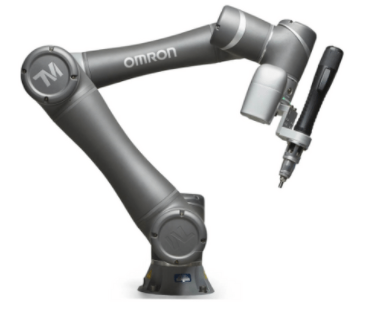Integration of collaborative robots
Collaborative robots in complete safety
Collaborative robots have revolutionized industry automatization and the robotisation of factories. Agile and simple to program, they do and will spread at high speed across industries … if safety is properly ensured.
Which interactions between robot and man ?
There are two main families of robots:
- Industrial robots : capable of high accuracy and fast speeds, they may also include safety functions to allow cooperation with the operator.
- Collaborative robots : capable of limited torque and limited speed, they can perform simple operations in collaboration with an operator.
They differ from each other according to the level of interaction with man
| Level of interaction | State of robot | Category of robot | Type of process | |
|---|---|---|---|---|
| 0 | No contact allowed. |
robot turned on |
Industrial production robot | The robot and the operator perform different actions in a shared space |
| 1 | Contact unwanted |
Robot shut off | Industrial production robot | The robot and the operator perform different actions in a shared space |
| 2 | Contact possible with static robot | Idle robot | Cooperative industrial robot | The robot and the operator perform different actions in a shared space |
| 3 | Contact possible but unwanted | Limited speed and torque | Cooperative industrial robot | The robot and the operator perform different actions in a shared space |
| 4 | Contact desired with simulaneous man-robot action | Limited speed and torque | Collaborative robot | The robot works with the operator 'hand in hand' |
How to safely integrate a collaborative robot?
All of the conditions that apply to the integration of industrial robots are relevant to collaborative robots. Nonetheless, the interaction with man requires complete and total control of safety functions. Depending on the level of interaction between robot and operator, a risk analysis compliant with industry standards (in particular the "Machines" 2006/42/CE guidelines and ISO 10218-1 and ISO 10218-2 standards) generally leads to several proposals from which to choose. Clients and SEMO collaboratively select the solution that best optimizes performance (in particular cycle time and thus productivity) and guarantees the level of safety required.


Why integrate a collaborative robot?
Collaborative robots enable the combination of robotic tasks with those of the operator. Expert call-outs are not always necessary due to the simplicity and user-friendliness of programming. Finally, the open system (without the need for physical barriers) makes physical reallocation easy. Cooperative robots can also meet the myriad of needs from the interaction between man and robot whilst delivering the precision and speed of industrial robots.